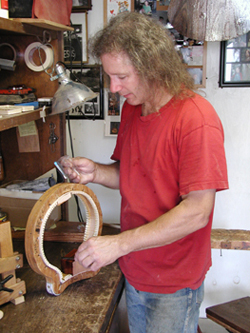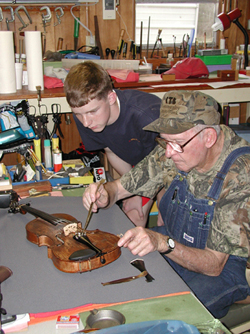Making Music: The Art of Hand-built Stringed Instruments
By Susan Roach
"If you vibrate or rub a string on a good fiddle, it's like tossing a pebble on a smooth pool of water, and the waves spread out evenly.
—Hilton Lytle
Stringed instrument builders are spread across Louisiana, making fiddles (violins), violas, guitars, mandolins, mandolas, bass fiddles, pedal steel and bass guitars, dulcimers, and hybrids such as mandoguitars and even cello bass fiddles in response to Louisiana's vibrant music traditions. Ron Yule's forthcoming book on Louisiana fiddling (Center for Louisiana Studies) includes a section on fiddle makers from southwest to northeast Louisiana. An instrument builder himself, Yule discusses forty-two other instrument builders who have made two or more fiddles and other instruments. Yule's list of the most prolific builders (making more than twenty instruments each) includes Locklin Melder, of Rapides Parish; Tex Grimsley, of Shreveport; J. C. Daniels, of Deville; Enoch Windham, of Starks; Bill Bryant, of Natchitoches; Leo Abshire, of Gueydan, and Lionel Leleux, of LeLeux; and Doc Savage and Hilton Lytle, of Monroe. These last two artists, along with Rick Felkel, a guitar and mandolin builder from a younger generation, make Ouachita Parish a center in the crafting of string instruments.
In the early days in Louisiana, many musicians had little money for instruments and few places to buy them, so enterprising musicians began making their own instruments, ranging from simple "gut bucket" one-string basses to complex violins patterned after Stradivarius. At age nine, Hilton Lytle made his first cigar box fiddle as a toy with screen door wires. Adner Ortego, from Washington, making fiddles since age fourteen states, "I wanted to play violin, but during the Depression, you couldn't buy one, so I made one," according to the Louisiana Folklife Center Biographies Website. Five other stringed instrument makers from various parts of the state are featured on the website: guitar and mandolin builders Luke Thompson, from Baton Rouge, and Shannon Mills, from Zachary, along with fiddle builders Adner Ortego, from Washington; Deborah Viator, from Eunice; and Tex Grimsley, from Shreveport.
Most instrument builders learn techniques from other builders, books, and trial and error; therefore, they often say that they are "self-taught," as does Luke Thompson, who began building in the mid-1960s, and says he learned "the hard way by asking questions, reading books, trial and error." In fact, many of the builders often consult books to learn basic techniques. Hilton Lytle, for example, found instructions in the Foxfire books and Strings magazine. However, most of them have learned enough from other instrument makers to justify calling them folk artists, that is, artists who learn their craft informally by observing and talking to other artists. Simsboro fiddler Fred Beavers and Hilton Lytle both credit Doc Savage, who died in 1974, for teaching them intricacies of the craft. For Bob Terry, of DeQuincy, Ron Yule was a valuable resource: "He could tell me more in thirty minutes; it would take me three months to incorporate what he could tell me. I'd take him the fiddle, and he would give me another thirty-minute talk, and I'd go back and build another fiddle until I got pretty good at it." As Terry puts it, "Fiddle makers are very generous with their time and help." This generosity has led to many informal and formal apprenticeships. Lytle has taught the craft to his brothers, Lloyd and Thomas, and many younger fiddlers including Britton Curry and T-Bow Lairsey. Past Louisiana fiddling champion Fred Beavers taught then seventeen-year old Ben Robinson, now the 2005 state champion, to build and repair fiddles through a state folklife apprenticeship.
Significantly, many of the builders have a strong traditional knowledge of timber and woodworking. Hilton Lytle, Rick Felkel, and Bob Terry all come from families who worked with wood. Lytle expresses this familiarity: "By the time I was ten years old, I knew the names of all the trees in the country, how they grew, how fast they grew." Felkel attributes his knowledge of woods to Lytle, "the first man that taught me about building and how to handle wood-the properties of wood, laws of nature." This knowledge led them to experiment with woods native to Louisiana. Felkel harvests and mills his wood with the old sawmill behind his house and carefully cures it, working with ash, oak, cherry, bois d'arc, and persimmon for instruments and beech for instrument forms. He has also used North Carolina black walnut from his father, also a woodworker. Although Felkel's favorite wood is cherry, he says, "More people in this world want black walnut than anything else," but echoing his mentor Lytle, he says, "Every piece of wood is not created equal." Lytle prefers to test individual pieces of wood for their strength using a variety of contraptions he has built. The majority of builders, including Bob Terry, purchase woods (European spruce, German maple, rosewood, etc.) from commercial companies such as the International Violin Co.
Although their motives for building instruments may have changed today, many builders still make string instruments as a hobby or business. One builder, Rick Felkel, who moved to Monroe thirty-two years ago from Elloree, North Carolina, says, "I really just started out a little over 700 instruments ago, to build myself a left-handed guitar; that's all I was really after. It's hard to find a left-handed instrument." He was working at the Piccadilly Cafeteria, when he got the idea to build an instrument about eleven years ago. Felkel learned little about woodworking from his father, so he learned mainly by looking at other guitars. After others saw his first guitar, they asked him to build for them, so over the next five years, he built about six instruments per year. Over the last six years with the help of his website, Elloree Guitars, Felkel's business has gradually evolved into a full-time profession. Working in his Elloree Guitars shop behind his house in the rural West Monroe area, he now makes about seventy-five instruments annually, specializing in custom instruments and native woods. With his instruments, he also provides photographs of all the building process. After retiring from the Conoco oil refinery in 1993, Bob Terry became interested in building fiddles: "I had wanted to build an instrument, and the first book I found in my woodworking catalog was to make fiddles, so I ordered the book." He continues to learn methods from books including his recipe for homemade varnish made with mineral and vegetable crystals, cooked down with linseed oil.
Stringed instrument building is highly technical, requiring putting together many parts; fiddles, for example, have some seventy parts. Techniques of preparing these parts vary according to instrument and builder. Some builders simply carve and plane down the top and back of the fiddle body to a certain thickness, while others like to tune the top to a certain note. The late Lionel Leleux, a well-known Cajun fiddle maker and musician, and Hilton Lytle focus much of their energy on tuning the plates (top and back) of the fiddle. According to Dunbar and Owens in Keeping It Alive: Cultural Conservation Through Apprenticeship, Lionel LeLeux would lightly tap the wood and listen for the pitch of the tone in order to determine how much wood to take from the back plate; he would plane the plate so that it rang a G note on a guitar. Lytle takes tuning a step further and has developed a system of tuning both the top and back plates to certain notes and then finding the balancing point of each plate so he can install the tone bar and sound post. He explains his process:
The thing I've been interested in doing-and my wife-we just did this for fun to have a project we could work on together. . . . We wanted to find out what notes go together to . . . give a violin a beautiful tone, and by carefully doing the top and the bottom and putting those two pieces together-if I can come up with an F# bottom and a G top, you'll get a beautiful sounding violin. . . . By measuring [with a micrometer], as you hollow this out with different kinds of tools-scraping tools, chisels, cutting tools, and rounded chisels that you keep real, real sharp-you can move that wood out and make a concave surface out of it. And if you can get this [the back] to ring like a bell [he hits it with a "knee-jerk" hammer the doctor gave him]. What I'm working at is to get this piece of wood tuned to a note. If I can thin that down and it can be F#, then if I can tune the top to a G-the bottom is an octave and a half step lower than the top.
After Lytle gets the two plates "tuned," he checks them for balance: "And then I put the tone bar in and balance that on a pencil point. Everything that you're doing is balanced, the top is perfectly balanced." Lytle's building has become a global endeavor since instead of building from scratch, he orders rough-cut violins machine made in China through a Nevada firm. The rough-cut violins reduce the building time from 240 to 60 hours, and Lytle can focus on "graduating" these to produce a balanced, tuned instrument. For someone who grew up in rural LaSalle parish, making his own toys, Lytle entertains himself building instruments. Over the years, he has also taught his skills in the apprenticeship program at the Ozark Folk Center in Mountain View, Arkansas, where a Lytle "graduated" fiddle can be purchased for $800. In spite of all the custom work that goes into handmade instruments, the prices are modest, ranging from $500-$2500.
Hand builders have great leeway adapting and customizing instruments. Rick Felkel, who builds "everything in the guitar, mandolin, and dulcimer families," has also built a couple of fiddles, but he thinks, "Fiddlers are so traditional that they don't like my violins. I don't like the wooden pegs that you tune with; they are just so aggravating. Guitars used to have those same kind of pegs. I'd never sell the first guitar if I tried to make one retro to be like guitars used to be." Felkel has also learned from repairing broken guitars: "I started building guitars the way I saw them built, and then it occurred to me, I'm building like all these that are breaking down; mine are going to break down," so now he modifies his designs and uses stronger woods. Many makers also sign, date and personalize the instrument, usually visible through the soundhole.
A hand-built instrument is also a unique work of art, whether using traditional or innovative designs. Debra Viator, Ron Yule, and Bob Terry have carved fiddle scrolls with heads of animals, people, mermaids, and skulls. Viator uses color finishes-"burnt sienna, chocolate, cherry red, deep forest green, midnight blue." Some such as Luke Thompson do custom inlay work. Thompson's work was so fine that he was given a contract from the Gibson Company to build mandolins. Handmade instruments are valued for their musical qualities as well. Lytle's violins, which are being played in the Dallas and St. Louis symphonies and by Allison Krause, are prized for their tone, sustain, and volume. Felkel says that he has built for "some big name folks," who "could play anyone's instrument, and some of them have chosen to play mine."
Regardless of the chosen instrument, these artists are all united by their passion for their craft. Tex Grimsley, who made fiddles from age fourteen until his death in 2002, related the driven nature of builders: "Something makes me whittle like it makes me play music, I can't quit. You have a feeling of doing something you've always wanted to do. And you're going to make a fiddle or bust."




